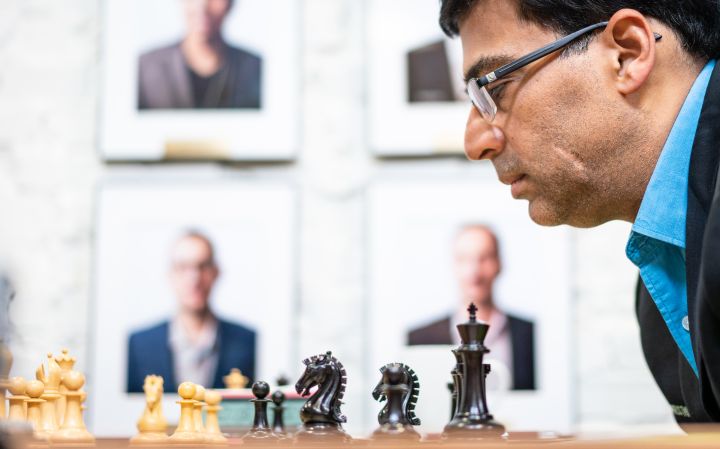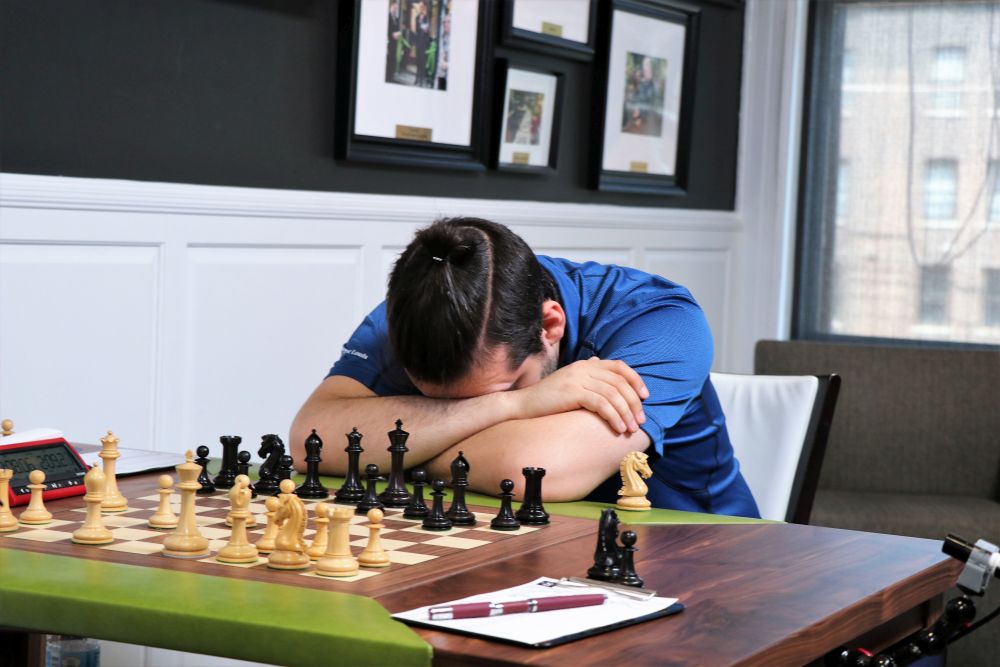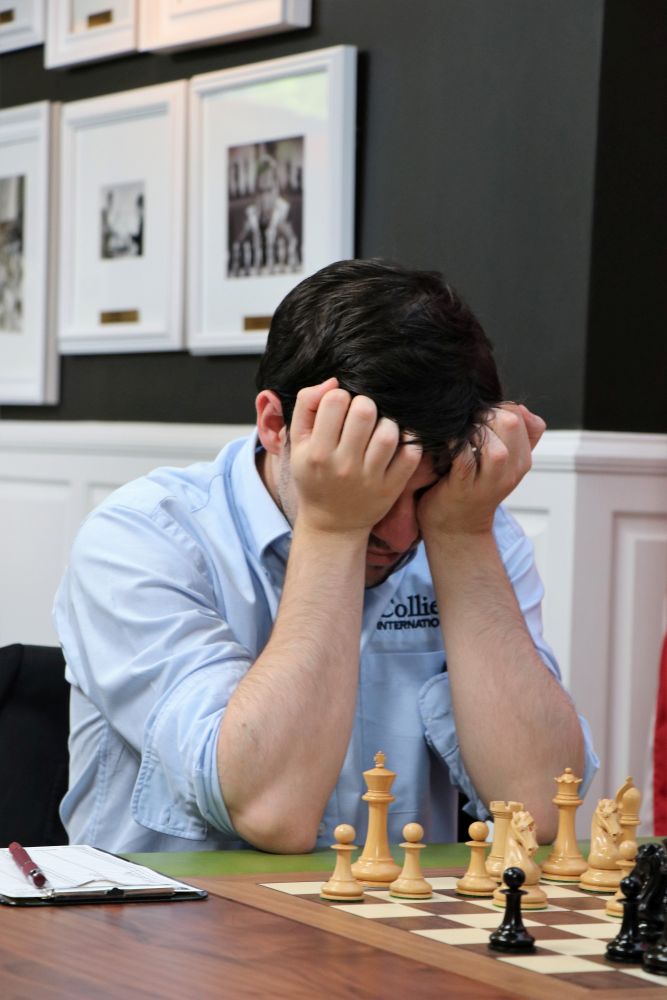


It’s a problem every player encounters when he stands better in a game: how to convert his plus into a full point? In this DVD the author answers this difficult question of chess strategy, considering both the psychological aspects of the realisation of an advantage and the technical methods.

World Champion Magnus Carlsen stated after the sixth round that 'this is definitely the time to make a move', in the first of his two whites in succession. He had played six draws so far, retaining his long undefeated streak in classical games of 85 games.
Carlsen walked to the Saint Louis Chess Club with his second Peter Heine Nielsen and father Henrik. After striding down to the tournament room a minute late, Carlsen sat down to face Ian Nepomniachtchi's Gruenfeld in an original way.
It was obvious that Carlsen was trying to steer the game into irregular territory, where he had definitely come well-armed. Surprisingly, Carlsen has already employed the move once in a game against Caruana in 2012, but it would have been difficult anticipate for today's game. The stage was set.
Faced with an obvious surprise in the opening, Nepomniachtchi took a minute to think how best to respond to the surprise. His body language at the table was of someone struggling to recall analysis buried deep within his memory.
The Grünfeld is a highly dynamic opening in which Black's position often seems to hang together by a single thread; and yet, this apparently precarious equilibrium appears to be enough to make it entirely viable — up to the highest level.

Working hard against an unexpected variation | Photo: V.Saravanan
But once he regained his composure, the moves came sure and fast, showing his thorough preparation level and confidence in going for a logical and bold continuation which might have had Carlsen's landmines strewn around.
10...♞b6 Nepo had employed 10...a6 in an earlier game here, but he whipped out his moves quite fast, indicating that he had alternatives ready for opening surprises as well. 11.♕a3 cxd4 12.cxd4 ♝g4 13.♖d1:
It looked like a clever piece of opening prep by Carlsen.
But Nepomniachtchi showed his remarkable fighting spirit. After a 5-minute think, he picked up the gauntlet with 13...♝xf3 14.♗xf3 — a new move. Only 14.gxf3 has been played before 14...♝xd4 15.e5!?
Sacrificing a pawn and playing fast, Carlsen made it obvious that he was still in his preparations, and showed his determination to play for a win. However, Nepomniachtchi matched him in spirit and insight of the position.
17...♝xa1 18.♖xd8 ♜fxd8.
And though Carlsen kept fighting for another 16 moves, Nepomniachtchi kept the balance and forced a draw. A game which could have been a great fight, but negotiated with simplicity by black pieces.
Understandably, Carlsen was resigned and philosophical in the after-game comments,
What can I say? (Nepomniachtchi) defended perfectly. Nothing I could do there. I tried fairly but he seems very well prepared. I couldn't see anything to fight for an advantage.
There was another board where there seemed to be a bizarre opening treatment.
The Bishop's Opening and The Italian Game
Studying the content of this DVD and adding these openings to your repertoire will provide players with a very strong tool to fight 1...e5 - as the practice of the author clearly demonstrates.
Here, Mamedyarov went with 8...♞e7 and after 9.d4 ♝b6 10.♗b3 he again retreated the knight back with the puzzling 10...♞c6?! The whole idea looked too creative, and he ended up in a mildly worse position, which probably left MVL a little puzzled on the board.

Maxim Vachier-Lagrave trying to understand his opponent's puzzling idea | Photo: V.Saravanan
MVL definitely had a slight edge from thereon, but he missed his chances to treat the position better.
16.c4 White had a better construction in 16.♘b5 with the idea of a2-a4, ♗c1-f4, ♕d1-d2 and ♖a1-d1
Here, MVL had a great opportunity to apply pressure on black with 22.h4 ♝h7 23.h5! thus, not allowing Black to free up his pawns in the kingside as well as the light squared bishop. But he erred with 22.♔f2 ♝h7 23.h4 g5 24.hxg5 hxg5 25.♖h1 ♞e5 and Black was en route to achieving equality.
Hikaru Nakamura surprised Levon Aronian by transposing from a Najdorf to the Dragon structure, and seemed to achieve easy equality with bold play against a tentative looking white setup.
Volume one of the DVD deals with 9.Bc4, White's sharpest option, and shows how Black can counter this ambitious try by White with the main lines of the Soltis variation (12...h5), which was played by Magnus Carlsen regularly as well.
12...g5 13.♗g3 ♝g4 14.f3 ♝e6 15.♗f2 d5!? and after achieving this pawn break, there seemed to be not much of a way for White to proceed.
The game hardly evinced any interest, though White was trying to exploit his symbolic advantage of having the pair of bishops, but Black found the correct time to equalize precisely.
34...♜d1! 35.♔e2 — if 35.♖xb6 ♞d4 (threatening ...f7-f5) 36.♖b7 ♚f8 37.f4 f5 38.♖b8+ ♚g7! achieving equality — 35...♜d4 36.♖xe6 fxe6 37.♗c3 ♝f6 with equality.
Already, White doesn't have much in this position. But just when everyone was expecting a plan like 16.g4 to gain space on the kingside, White unexpectedly played 16.♗xb8?! It is extremely difficult to understand this capture. If White's idea was to force an ending with a good knight versus bad bishop, he never even got an ounce of a chance in further course of the game. The game never reached any heights of excitement afterwards.
Finally, we come to the game which won't give the former world champion any pleasant feelings, considering the fact that it is coming after many missed opportunities in the sixth round.
After 1.d4 Nf6 2.c4 e6 3.Nf3 Bb4+ Black develops smoothly and prepares to castle. He retains maximum flexibility with his central pawns. You do not need to know an enormous amount of theory to play.

Anand reaching the tournament hall along with Indian GM Sandipan Chanda, his second for this event | Photo: V.Saravanan
A quiet position arising out of a Bogo-Indian, familiar to both players. Ding has played 9.♗f4, 9.♖d1 and 9.♖c1 in the past here, and he sprang a mild surprise with 9.a4:
When the former world champion played 12...e5 here, it looked like a committal decision, but still, White didn't seem to have much of an opening advantage any more, the position being objectively equal.
In a perfectly level-looking position, Ding sprang a surprise with 17.♗h3? This looked like a provocation, more than anything, hoping for 17...g5 18.♘xd5 ♞xd5 19.♕xc8 ♛xc8 20.♖xc8 ♜xc8 21.♗xd7 with a wild position, but Anand simply continued with 17...♜c6 18.♕b3 ♞b6 and Peter Svidler felt that 'Ding is in significant amount of trouble here'. White was suddenly staring down the barrel, as his kingside had been weakened, which unfortunately both the players did not realize, now or later. Alejandro Ramirez was shocked by the way Ding played immediately after the opening phases — recklessly — instead of the subtle strategic play he is known for. “We were singing his praises and the guy does this!”, Ramirez said.
19.♗xa5?? Played instantly, which was guessed by Cristian Chirila as a kind of false bravado, “When Ding blunders, he plays instantly!” At this point, Magnus Carlsen was in the studio after his game, and he opined 'Ding is busted!'
19...♝xh3 20.♘xh3 ♛c8 21.♔g2
Strategy University Vol. 4: The technique of realising the win
Great players of the past used to say – the most difficult thing in chess is to win won positions! Every player has such problems – those at the top of the tree and (especially) juniors. The correct technique consists of proper exchange methods and of the continuation of a correctly chosen plan; it is important not to change strategy after a small material gain. The DVD shows and explains instructive mistakes made when trying to make extra material or a positional advantage count and in addition it demonstrates the correct techniques as employed in classic games.
21...♜xc1 Black is clearly better after this, but he missed an imaginative way of generating an attack against the white king with 21...♞c4!! with the straight point that the obvious 22.♗b4 is met with 22...♞g4! with the idea of 23...♜h6 and black is completely winning.
22.♖xc1 ♛xc1 23.♗xb6

Vishy Anand looked extremely tense after gaining a winning position against Ding Liren | Photo: Lennart Ootes / Grand Chess Tour
Anand is an exchange up just for a pawn, and he is considerably better. Further he played 23...e3! 24.f3 h5! tightening the screws, and he seemed to be well on his way to an easy win.
26...♛c6? “Looks strange to me” said Nakamura about the move.
This position was analysed by many of the participants of the tournament (who came to the studio to analyse their own games) as well as commentators including Maurice Ashley, Yasser Seirawan, Peter Svidler, Cristian Chirila and Alejandro Ramirez, all of whom found the winning move 26...♞e4!! at varying speed. Especially striking was the analysis of Nakamura who found the move in about 20 seconds of thinking out loud. The underlying point is that, white cannot capture 27.fxe4 ♜xe4 28.♕xd5 ♜xh4 29.♔f3 ♛h1+ winning. If white doesn't capture the knight, for example against 27.♕xd5, he continues 27...♞d2 28.♗xd2 exd2 and he wins in a variety of ways.
Nakamura had an interesting insight about Anand's play here, telling that:
Vishy would have found the move 26...♞e4!! in about two minutes in the 90s, when he was the 'Speed Demon' and 'Tactical Monster'. I think the nature of the game has changed, because of computers. You don't have the crazy attacking games (anymore). The game (of chess) has petered out (tactically), as everyone understands each other's ideas, and it is really hard to create significant imbalances.
That's an unorthodox way of justifying why even top players miss their tactics nowadays?
Once he missed this, Anand slowly allowed Ding to crawl back into the game missing a few more chances to win, and though it was a long fight, he almost never achieved a winning position after the queens were exchanged. Even though he had more than 50 minutes on his clock, Anand looked visibly nervous and lacked decisive play to finish off the game.
Commentary by WGM Jennifer Shahade and GMs Yasser Seirawan and Maurice Ashley